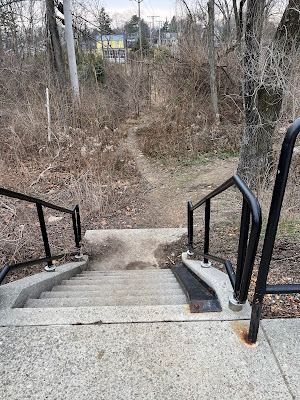“Why can’t we just keep our lovely suburbia?” (Resident, Greater Timonium Community Council in a public meeting)
Sometimes real life provides quotes that are better than anything you can make up. The above exclamation is such a case. It is a headscratcher for the fact that few people would America's standard edition suburb as a thing of beauty. Especially if one knows the 13 acres of land in question that caused this exclamation, a largely defunct shopping Center between York Road and the Central Light Rail in Lutherville, the shopping center as well as the LRT station known as the Lutherville Station. Ok, the shopping center is a sea of asphalt, no green, non descript boxy buildings, in short: It is ugly. And so is pretty much everything else lining York Road a mile south or a mile north. |
| Big, ugly and underperforming: Lutherville Station as seen from the light rail station with the same name (Photo: Philipsen) |
"There is a petition with thousands of people signed. They're against it. We just don't want the crowding," (Community member)
 |
| A sea of asphalt and parking isn't "transit oriented development (Google Maps Screenshot) |
- 13 acres of underutilized commercial real estate close to the Baltimore Beltway, I-81 and adjacent to an existing light rail line
- a developer who thinks that there could be a better and higher use than half vacant retail .
- A proposal for "mixed use" with 400 apartments, offices and retail and 2.5 acres of open space. largely mimicking the existing building heights and massing
- An underperforming 30 year old light rail line
- A single family neighborhood to the west of the north-south rail line with no formal pedestrian access to neither transit or shopping
- A transit study investigating the options for an additional north south transit corridor between downtwon Baltimore and Towson that would use the nearby York Road corridor and connect at Lutherville.
- Several alignment options for this new transit corridor would take away road space from York Road, a State Highway (MD 45)
The current light rail line is underperforming precisely because each of the jurisdictions the line traverses failed to change zoning so more people would live and work near the stations and bring riders to the system. As a result far more people drive than would be necessary.
As a result of failed land use planning, employees without a car have three times the commute times of those who drive, because where people live and where the jobs are isn't properly connected by anything but roads for cars.
There is a housing crisis because somebody always objects when denser or more affordable housing is proposed. Finally, we have a climate crisis as a result of all of the above. Sprawl is the least sustainable form of land use there is, driving up the CO2 production of inefficient buildings as well as that of transportation (in the US each representing 40% of total CO2 emissions respectively.) To boot, as a letter writer to the SUN points out, the "lovely suburbs" are also fiscally not sustainable and tend to slide into worse predicaments than the maligned cities.
The suburban development pattern combines the openness of rural communities with the infrastructure standards of urban communities. The result is communities that are impossibly expensive to maintain (given the tax base). Extending the reach of roads, water, sewer, trash pick-up, etc., throughout (low-density) suburbs requires tremendous resources, both up-front and ongoing.
A train without development: Vast amounts of underutilized lands
Property taxes fall significantly short of covering the high cost of maintaining everything that many suburban residents have been led to believe are givens. The only reason our suburban pattern of development has been able to continue on for as long as it has without collapsing is because of constant growth, a set-up which amounts to a Ponzi scheme. (Strong Towns Baltimore)
The just re-elected County Executive Olszewski has all hands full trying to steer his county out of the treacherous "culture" of glorifying the suburban life as a juxtaposition to city life. His counterparts in Howard and Anne Arundel Counties are on a similar journey. In their second terms they all have an opportunity to show that no crisis can be mastered by simply listening to the loudest NIMBY opponents who don't want to see any change."I asked [Olszewski] to put a halt to the process. He has. He's held it back from the planning board for their approval or disapproval. I think that the TOD is not the right way to go," (County Council Wade Kach on Jan 11,2023)
 |
| Alternative alignments and modes under study for a City to Towson corridor |
Klaus Philipsen, FAIA
The article has been updated

Proposed concept plan from the developer's
PUD application


No comments:
Post a Comment